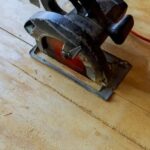Are you wondering how to remove paint from intricate woodwork? Intricate woodwork adds a touch of elegance and character to any space, but removing paint from such detailed surfaces can be a daunting task. Whether you’re restoring an antique piece or revitalizing a historic home, understanding the importance of intricate woodwork and the challenges of removing paint from it is essential.
In this comprehensive guide, we will explore the tools and materials needed for the paint removal process, as well as provide tips on preparing the woodwork before tackling the project. We will also delve into various methods for removing paint from intricate woodwork, including chemical stripping, heat gun application, and sanding. Our step-by-step instructions will walk you through each method, ensuring that you are equipped with clear and easy-to-follow guidance.
As we navigate through this article, we will also address important safety precautions to consider while removing paint from intricate woodwork. Additionally, we will provide additional tips and tricks for effectively and efficiently removing paint, such as tackling hard-to-reach areas. So if you’re ready to take on your own paint removal project on intricate woodwork, keep reading for all the information you need to achieve great results.
Tools and Materials
Removing paint from intricate woodwork requires the use of specific tools and materials to ensure a successful and safe process. Here is a comprehensive list of the items you will need:
1. Chemical paint stripper: An effective option for removing multiple layers of paint from intricate woodwork.
2. Heat gun: Useful for softening paint layers, making them easier to scrape off delicate woodwork.
3. Sandpaper or sanding blocks: Essential for smoothing out the wood surface after paint removal.
4. Scrapers and putty knives: Ideal for removing softened or loosened paint without damaging the woodwork.
5. Protective equipment: This includes safety goggles, gloves, and a respirator to protect yourself when working with chemical strippers or heat guns.
In addition to these specific tools, it’s also important to have basic cleaning supplies such as rags, soap, and water for prepping the wood before paint removal, as well as aftercare once the process is complete.
When tackling intricate woodwork projects, having the right tools at your disposal is crucial for achieving the best results while ensuring safety throughout the entire process. Whether using chemical strippers or heat guns, being properly equipped allows for a more efficient and effective paint removal experience.
Preparing the Woodwork
Before diving into the process of removing paint from intricate woodwork, it is crucial to properly prepare the surface. This step ensures that the paint removal process is smooth and successful, resulting in a pristine finish for your woodwork. Here are some essential tips on how to prepare the woodwork before removing the paint:
- Start by cleaning the woodwork thoroughly with a mild detergent and water. Use a soft brush or cloth to remove any dirt, dust, or grime that may have accumulated on the surface.
- Once the woodwork is clean, allow it to dry completely before proceeding to the next step. Moisture can interfere with the effectiveness of paint removal methods, so it’s important to ensure that the surface is completely dry.
- Inspect the woodwork for any rough or uneven areas. Use a fine-grit sandpaper to gently sand down these imperfections, creating a smooth and even surface for paint removal.
Properly preparing your intricate woodwork sets the stage for successful paint removal without causing damage to the underlying surface.
It’s also important to consider using protective equipment during this preparation phase. Wear gloves and safety goggles to protect your hands and eyes from any potential hazards posed by cleaning agents or sanding residue. Taking these precautions will ensure a safe and effective preparation process for removing paint from intricate woodwork. Stay tuned for our next section on different methods for paint removal.
Methods for Paint Removal
When it comes to removing paint from intricate woodwork, there are several methods that can be used, each with its own advantages and challenges. It is important to carefully consider the method that will work best for the specific type of woodwork and the type of paint that needs to be removed. Here are detailed explanations of three common methods for removing paint from intricate woodwork:
- Chemical Stripping: This method involves applying a chemical paint stripper to the woodwork in order to break down and remove the layers of paint. It is effective for intricate details and hard-to-reach areas, but it requires careful handling of the chemicals and proper ventilation to ensure safety.
- Heat Gun: Using a heat gun is another method for removing paint from intricate woodwork. The heat gun softens the paint, making it easier to scrape off with a putty knife or other scraping tool. This method allows for greater control over the process, but it also requires caution to avoid damaging the woodwork or creating a fire hazard.
- Sanding: Sanding is a traditional method for removing paint that involves using sandpaper to manually sand away the layers of paint. While this method may take longer than chemical stripping or using a heat gun, it allows for precise control over the process and can result in a smooth finish on the woodwork.
Before choosing a method for paint removal, it is important to carefully assess the condition of the woodwork and consider factors such as the type of paint, any existing finishes, and personal safety preferences.
Each of these methods has its own set of benefits and challenges, so it’s crucial to weigh these factors when deciding how to tackle your intricate woodwork project.
It’s also worth noting that some projects may require a combination of these methods in order to achieve the best results. For example, using chemical stripping followed by sanding may provide thorough paint removal while preserving the delicate details of the woodwork. Regardless of which method or combination you choose, patience and attention to detail are key when working on intricate woodwork projects.
Step-by-Step Instructions
Removing paint from intricate woodwork can be a challenging but rewarding process, especially when done correctly. Whether you’re restoring antique furniture or simply refreshing the look of your home, knowing how to remove paint from intricate woodwork is essential. In this section, we will provide a step-by-step guide on how to tackle this task effectively, no matter which method you choose to use.
The first step in removing paint from intricate woodwork is to assess the condition of the wood and the type of paint that needs to be removed. Once you have determined these factors, you can choose the most suitable method for paint removal. The three main methods for removing paint from woodwork are chemical stripping, heat gun, and sanding.
If you opt for chemical stripping, make sure to work in a well-ventilated area and wear protective gear such as gloves and goggles. Apply the stripping agent evenly over the painted surface and allow it to sit for the recommended time before scraping off the softened paint with a putty knife or scraper. Be sure to follow all safety precautions and manufacturer instructions when using chemical stripping products.
Using a heat gun requires caution and precision. Hold the heat gun at a distance from the woodwork and move it slowly across the painted surface until the paint begins to bubble. Then, gently scrape off the softened paint with a putty knife while being careful not to damage the wood underneath.
For sanding, start with medium-grit sandpaper to remove most of the paint, then switch to fine-grit sandpaper for a smooth finish. Always sand in the direction of the grain and take your time ensuring you don’t remove more material than necessary.
| Methods | Key Points |
|---|---|
| Chemical Stripping | Work in a well-ventilated area – Wear protective gear – Follow manufacturer instructions |
| Heat Gun | Use caution and precision – Gently scrape off softened paint – Avoid damaging underlying wood |
| Sanding | Start with medium-grit sandpaper – Switch to fine-grit sandpaper for smooth finish – Sand in direction of grain |
No matter which method you choose, always take proper safety precautions and follow best practices for removing paint from intricate woodwork. With patience and attention to detail, you can achieve fantastic results and restore your woodwork to its former beauty.
Safety Precautions
When removing paint from intricate woodwork, it is crucial to prioritize safety throughout the process. Dealing with chemicals and potentially harmful substances requires careful attention to detail and adherence to safety precautions. Here are some important tips to consider for ensuring safety while removing paint from intricate woodwork.
Proper Ventilation
One of the most essential safety precautions when removing paint from intricate woodwork is to ensure proper ventilation in the work area. This means working in a well-ventilated space or using fans and ventilation systems to prevent the buildup of fumes from chemical stripping agents or the use of a heat gun. Adequate ventilation helps to minimize exposure to potentially harmful vapors and particles, promoting a healthier and safer working environment.
Handling of Chemicals
When employing chemical stripping agents to remove paint from intricate woodwork, it is imperative to follow all manufacturer instructions for safe handling and application. This includes wearing protective gear such as gloves, goggles, and a respirator to shield against skin contact, eye irritation, and inhalation of fumes. Additionally, it is crucial to handle and dispose of chemical stripping agents according to local regulations and guidelines in order to minimize environmental impact and maintain personal safety.
Minimize Fire Hazards
If using a heat gun for paint removal on intricate woodwork, it is important to be mindful of fire hazards. Keep flammable materials away from the work area, such as rags soaked with solvents or any other combustible items that could ignite when exposed to high temperatures.
Always follow proper usage guidelines for the heat gun and never leave it unattended while hot. By being cautious around potential fire risks, you can significantly reduce the likelihood of accidents during the paint removal process.
By prioritizing proper ventilation, safe handling of chemicals, and minimizing fire hazards during the paint removal process on intricate woodwork, individuals can ensure a safer environment for themselves as well as better results in their project. Adhering to these safety precautions not only protects against potential health risks but also promotes a more efficient and effective paint removal experience overall.
Tips and Tricks
Removing paint from intricate woodwork can be a daunting task, especially when trying to reach those hard-to-reach areas. However, with the right tips and tricks, it is possible to effectively and efficiently remove paint from even the most detailed woodwork.
Use Detail Brushes and Tools
When dealing with intricate woodwork, using small detail brushes and tools can make all the difference. Look for fine bristle brushes or small scrapers that are designed specifically for intricate work. These tools can help you remove paint from detailed areas without damaging the wood or affecting the intricate design.
Utilize Softening Agents
For hard-to-reach areas where paint removal is particularly challenging, consider using softening agents. These products can help loosen the paint, making it easier to remove from intricate areas. Be sure to follow the manufacturer’s instructions and use caution when applying these products, as they may contain chemicals that require proper ventilation and protective gear.
Take Your Time
One of the most important tips for tackling intricate woodwork is to take your time. Rushing through the paint removal process can lead to mistakes and damage to the woodwork. Patience is key when working on detailed areas, so be sure to allow yourself plenty of time to carefully remove the paint without causing harm to the intricate design.
By following these tips and tricks, you can effectively remove paint from intricate woodwork, including those hard-to-reach areas that may seem challenging at first glance. With patience, attention to detail, and the right tools at your disposal, you can achieve a beautifully restored piece of woodwork that showcases its intricate design once again.
Finishing Touches
After successfully removing paint from intricate woodwork, it is crucial to complete the process with the proper finishing touches. This final step will not only enhance the appearance of the woodwork but also protect it from future damage. The finishing touches include sanding and applying a new finish or stain to bring out the natural beauty of the wood. In this section, we will provide guidance on how to effectively finish the woodwork after paint removal.
The first step in finishing the woodwork is sanding. After removing the paint, there may be residual marks or uneven surfaces that need to be smoothed out. Use a fine-grit sandpaper to gently sand the entire surface of the woodwork. Pay special attention to any detailed or intricate areas, ensuring that all traces of paint are completely removed and the surface is smooth and even.
Once the woodwork has been thoroughly sanded, it is time to apply a new finish or stain. This step not only adds visual appeal but also serves as a protective layer for the wood. Choose a finish or stain that complements the natural beauty of the wood and suits your desired aesthetic.
Apply an even coat of finish or stain using a brush or cloth, following the manufacturer’s instructions for drying and curing times. Multiple coats may be necessary for optimal results, so be sure to allow sufficient drying time between each application.
By following these steps for finishing touches after paint removal, you can transform your intricate woodwork into a stunning showcase piece in your home. Through proper sanding and application of a new finish or stain, you can preserve and enhance the natural beauty of the wood while protecting it for years to come. Whether it’s an antique piece of furniture or architectural detail, taking care in this final stage will ensure that your intricate woodwork shines with timeless elegance.
Furthermore, remember that safety precautions should still be observed during this phase of the project-wearing protective gear such as gloves, goggles, and mask to shield yourself from potentially harmful chemicals found in finishes and stains is crucial. Always work in a well-ventilated area when applying finishes or stains to prevent inhaling fumes and minimize exposure to harmful vapors.
Conclusion
In conclusion, removing paint from intricate woodwork can be a challenging task, but with the right tools, materials, and methods, it is definitely achievable. The importance of preserving the beauty of intricate woodwork cannot be overstated, and taking the time to remove old, peeling paint can breathe new life into these stunning features of any home.
Throughout this blog post, we have discussed the various tools and materials needed for the paint removal process, as well as detailed methods for removing paint from intricate woodwork. Whether you choose chemical stripping, a heat gun, or sanding, it’s important to follow safety precautions and prepare the woodwork properly before beginning the process.
With step-by-step instructions provided and additional tips and tricks for tackling hard-to-reach areas, readers should feel empowered to take on their own paint removal projects on intricate woodwork. By following the guidance in this article and exercising patience and care, you can restore the natural beauty of your woodwork and give it a fresh new look. Remember to finish off the process with sanding and applying a new finish or stain for a polished final touch.
Frequently Asked Questions
How Do You Remove Old Paint From Detailed Wood?
Removing old paint from detailed wood can be a delicate process. One effective method is using a chemical paint remover and then scraping the softened paint with a putty knife. Sanding can also be used, but must be done carefully to avoid damaging the wood.
How Do You Get Paint Out of Crevices?
Getting paint out of crevices requires patience and precision. A small brush or toothbrush can be used to carefully scrub the crevices, while a dental pick or putty knife can help remove stubborn paint. If necessary, a chemical paint remover may also be helpful.
How Do You Remove Paint From Particle Board?
Removing paint from particle board requires caution, as excessive moisture or harsh chemicals can damage the board. Start by gently scraping off as much paint as possible, then use sandpaper to remove the remaining layers. It’s important to work carefully to avoid causing any harm to the particle board surface.

Hi everyone! I’m a woodworker and blogger, and this is my woodworking blog. In my blog, I share tips and tricks for woodworkers of all skill levels, as well as project ideas that you can try yourself.





